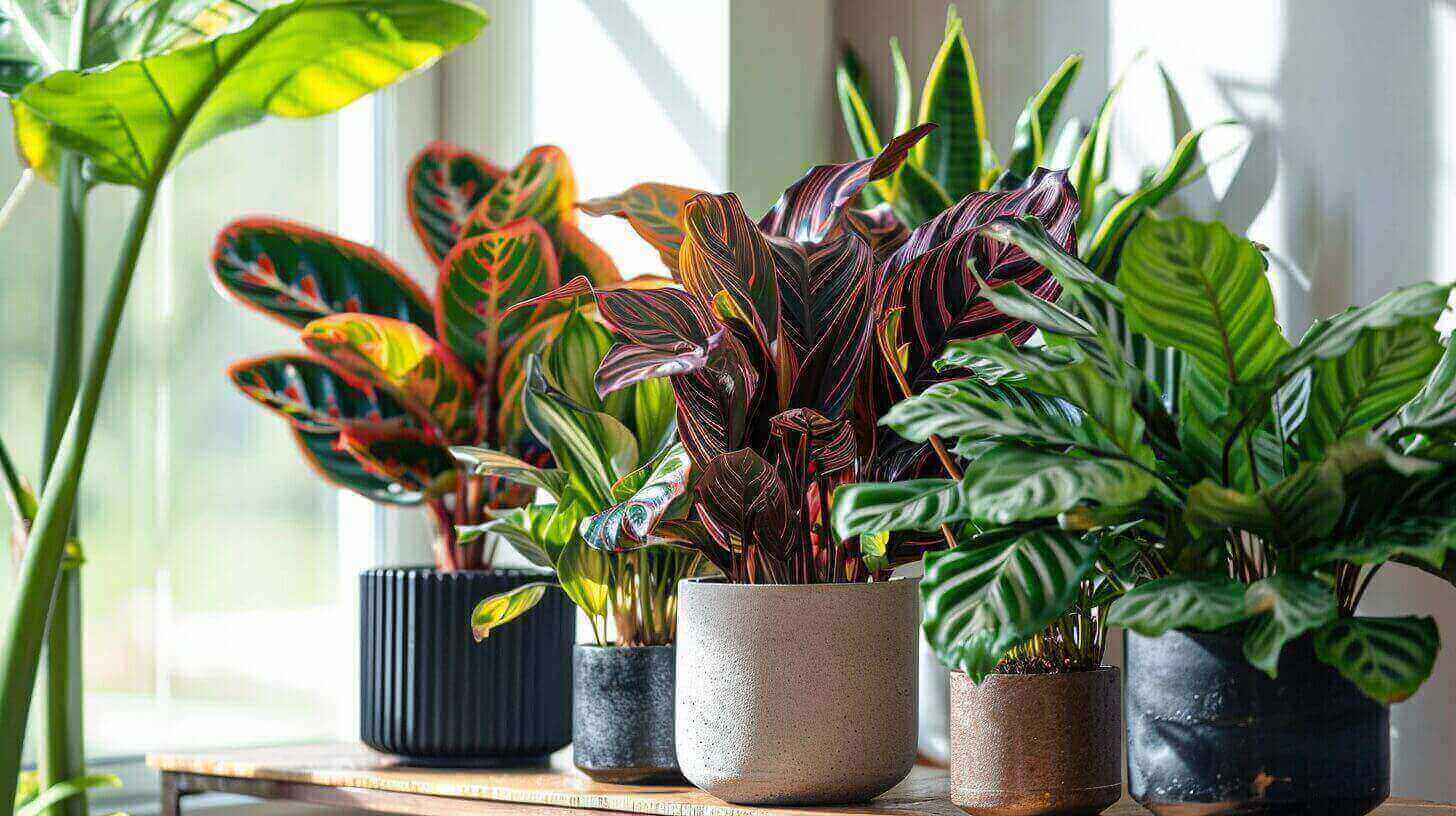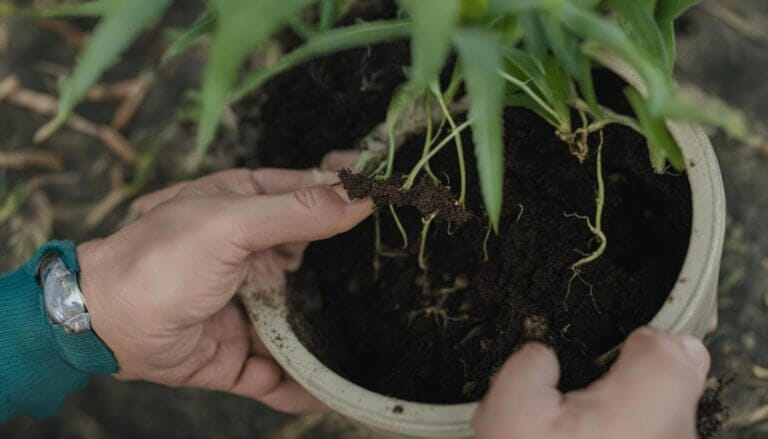Grow and Care for Calathea Plant: Calathea Care Tips and What to Avoid
Calatheas are beautiful house plants with stunning foliage, often intricately patterned in shades of green. They are also known as the peacock plant, cathedral window plant, zebra plant, and rattlesnake plant. Calatheas thrive in low light levels but need plenty of humidity. They should be placed in bright, indirect light and kept away from direct sunlight. The soil should be kept consistently moist during the growing season, using filtered or distilled water. Mist the leaves daily or place the plant on a tray of moist pebbles to increase humidity. Avoid using tap water, as calatheas are sensitive to the chemicals it contains. Common problems with calatheas include brown tips, yellowing leaves, and brown edges, which can be caused by underwatering, overwatering, exposure to direct sunlight, dry air, or hard water. Different varieties of calatheas include Calathea crocata, Calathea zebrina, Calathea lancifolia, Calathea orbifolia, and more.
Key Takeaways:
- Growing stunning calathea plants varieties adds a touch of beauty to any indoor space.
- Calatheas thrive in low light levels but need plenty of humidity.
- Place calatheas in bright, indirect light and keep them away from direct sunlight.
- Keep the soil consistently moist during the growing season using filtered or distilled water.
- Avoid using tap water to prevent damage to the sensitive calathea leaves.
Where to Grow Calathea: Ideal Conditions and Placement
When it comes to growing stunning calathea plants, choosing the right location is crucial for their well-being. Calatheas thrive in bright, indirect light, making them perfect for areas with low light levels in your home. However, it’s important to keep them away from direct sunlight, which can scorch their delicate leaves. Placing your calathea near a north or east-facing window is ideal to provide just the right amount of light.
Another factor to consider is the temperature and humidity. Calatheas prefer temperatures ranging from 65°F to 85°F (18°C to 29°C). Avoid placing them in rooms with regular temperature fluctuations or draughts, as these conditions can stress the plants. To create the perfect environment for your calathea, a room with high humidity, such as a bathroom, is ideal. Alternatively, you can increase humidity by misting the leaves daily or placing the plant on a tray of damp pebbles.
Where to Grow Calathea: Ideal Conditions and Placement
- Choose a location with bright, indirect light
- Avoid direct sunlight and draughts
- Ideal temperature range: 65°F to 85°F (18°C to 29°C)
- High humidity environments like bathrooms are perfect
- Mist the leaves daily or use a tray of damp pebbles to increase humidity
In addition to these conditions, it’s important to note that calatheas are sensitive to cold drafts or sudden temperature changes. Avoid placing them near air conditioning vents or open windows during colder months.
Creating the perfect conditions for your calatheas will ensure they thrive and display their stunning foliage. With the right placement, temperature, and humidity, you’ll be able to enjoy the beauty of these unique houseplants in your home.
Calathea Care Tips: Watering, Soil, and Fertilizing
Proper care for calatheas involves attention to watering, soil conditions, and fertilizing. By following these care tips, you can ensure your calathea plants thrive and remain healthy.
Watering:
Calatheas have high water requirements and should be watered when the top inch of soil feels dry to the touch. It is important to use filtered or distilled water, as tap water may contain chemicals that can harm the sensitive roots. If you only have access to tap water, let it sit out overnight to allow the chlorine and other chemicals to evaporate. Overwatering can lead to root rot, so it’s essential to strike the right balance. Remember, it’s better to slightly underwater than to overwater your calatheas.
Soil:
Calatheas thrive in well-draining soil that is rich in nutrients and organic matter. The soil should retain moisture without becoming waterlogged. You can achieve this by blending potting soil with perlite or sand to enhance drainage. Avoid using heavy clay-based soil, as it can cause water to pool around the roots and lead to root rot.
Fertilizing:
Fertilizing calatheas is important to provide them with the necessary nutrients for healthy growth. During the growing season, which typically occurs in spring and summer, use a balanced liquid fertilizer diluted to half strength. Alternatively, you can use organic amendments like seaweed or fish emulsion. Apply the fertilizer every two to four weeks, following the instructions on the product packaging. Be careful not to overfertilize, as it can cause leaf burn and other issues.
| Watering | Soil | Fertilizing |
|---|---|---|
| Water when top inch of soil is dry | Well-draining soil rich in nutrients | Use balanced liquid fertilizer during the growing season |
| Use filtered or distilled water | Avoid heavy clay-based soil | Dilute fertilizer to half strength |
| Avoid overwatering | Blend potting soil with perlite or sand | Apply every two to four weeks |
By following these care tips, you can provide the optimal conditions for your calatheas and enjoy their stunning foliage for years to come.
Propagating Calathea: Dividing and Repotting
Propagating calathea plants through division during repotting is a simple and effective way to expand your collection. By separating the clumps of the root system, you can create new plants that will thrive in their own pots. To propagate calatheas, follow these steps:
- Carefully remove the calathea plant from its current pot, gently loosening the soil around the roots.
- Inspect the rootball for natural divisions or clumps. If clumps do not separate easily, you can use a clean, sharp knife to cut through the rootball.
- Each clump should have a portion of the root system attached. Ensure that each division has enough roots to support its growth.
- Select new pots for each division. The new pots should be slightly larger than the current pot to allow room for growth.
- Fill the new pots with fresh compost, creating a well-draining environment for the propagated calatheas.
- Plant each division in its own pot, ensuring that the roots are covered with soil and the plant is stable.
- Water the newly potted divisions thoroughly, allowing the soil to become moist but not waterlogged.
It is recommended to repot calatheas every couple of years into slightly larger pots to provide ample room for growth. This process also helps refresh the soil and prevent the plant from becoming root-bound. By propagating and repotting calatheas, you can enjoy a thriving collection of these stunning plants.
Propagation Tips:
When propagating calatheas, it’s important to handle the plants with care to avoid damaging the delicate roots. Here are a few tips to ensure successful propagation:
- Choose healthy, well-established calathea plants for propagation. They will have a better chance of thriving as separate divisions.
- Water the newly propagated calatheas regularly, keeping the soil consistently moist during the initial stages of growth.
- Place the newly potted divisions in a location with bright, indirect light, away from direct sunlight.
- Monitor the humidity levels around the propagated plants and consider using a pebble tray or misting the leaves to increase humidity.
With the proper care and attention, your propagated calatheas will establish themselves in their new pots and continue to grace your home with their stunning foliage.
Common Calathea Problems and Troubleshooting
When caring for calatheas, it’s important to be aware of common problems that may arise. One issue you may encounter is curling leaves. This can be caused by underwatering or low humidity. To remedy this, make sure to water your calathea regularly and increase humidity by misting the leaves or using a tray of damp pebbles.
Another problem to watch out for is yellowing or wilting leaves. This can be a sign of overwatering or exposure to direct sunlight. To prevent this, allow the top inch of soil to dry before watering and place your calathea in a location with bright, indirect light.
Brown patches on the leaves can also be a concern. This can be caused by a variety of factors including dry air, overfeeding, or pests. To address this issue, increase humidity, avoid overfertilizing, and inspect your plant for any signs of pests such as red spider mites. If pests are present, treat them accordingly to prevent further damage.
If you notice faded leaves or small brown patches with a yellow halo, your calathea may be suffering from leaf spot. Remove any affected leaves promptly to prevent the spread of this fungal disease. Additionally, make sure to adjust watering and avoid overhead watering which can contribute to the development of leaf spot.
FAQ
What is a calathea plant?
A calathea plant is a type of houseplant known for its striking foliage. It’s part of the Marantaceae family, also known as prayer plants. Calatheas are tropical plants that are native to the tropical Americas.
How do I care for a calathea plant?
Calathea care involves providing the right amount of light, water, and humidity. They prefer indirect light, as direct sunlight can cause the leaves to turn brown. Water your calathea when the top inch of the soil is dry, using distilled water or rainwater if possible. Calatheas also thrive in high humidity, so consider using a humidifier or placing your plant on a pebble tray filled with water.
What are some popular varieties of calathea?
There are many popular varieties of calathea, each with its own unique foliage. Some of these include the peacock plant (calathea makoyana), zebra plant (calathea zebrina), rattlesnake plant (calathea lancifolia), and the medallion calathea (calathea roseopicta).
How do I propagate a calathea plant?
The best way to propagate calathea plants is by division. This involves removing the plant from its pot, gently dividing the plant at the roots, and repotting the divisions. This is best done during the growing season.
Can calathea plants be grown indoors?
Yes, calathea plants are generally grown as indoor plants. They prefer conditions that mimic their native tropical environment, with indirect light, high humidity, and warm temperatures.
How much light does a calathea plant need?
Calathea plants prefer indirect light. Direct sunlight can cause the leaves to fade and lose their vibrant patterns. A north or east-facing window is typically a good location.







